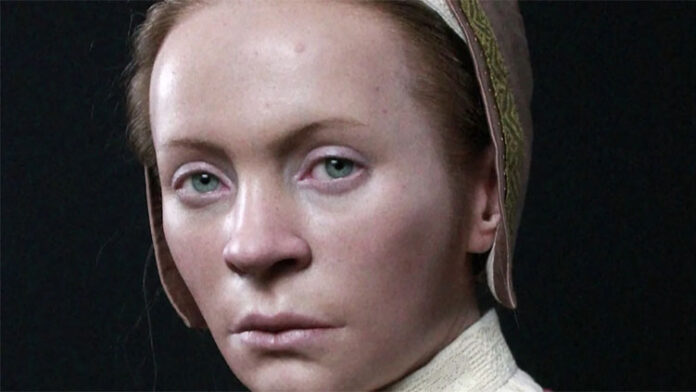PIEN, Poland (Reuters) – Buried with a padlock secured to her foot and an iron sickle placed across her neck, a young woman known as “Zosia” was never meant to rise again from the grave. Interred in an unmarked cemetery in Pien, a town in northern Poland, she was one of many individuals believed by her community to be a “vampire.”
In a remarkable intersection of modern science and ancient superstition, a team of researchers has now utilized DNA analysis, 3D printing technology, and modeling clay to reconstruct Zosia’s face, revealing the human story obscured by the supernatural fears of her time. This effort highlights not only the scientific advancements of today but also serves as a poignant reminder of the societal beliefs that shaped the lives—and deaths—of people centuries ago.
“It’s really ironic in a way,” noted Swedish archaeologist Oscar Nilsson. “The very people who buried her took extensive measures to prevent her from returning from the dead. Now, we are doing everything we can to bring her back to life.” This sentiment captures the duality of Zosia’s existence; she is seen as both a victim of her community’s fears and a subject of scientific inquiry.
Zosia was discovered in 2022 by archaeologists from Nicolaus Copernicus University in Torun. Radiocarbon dating revealed that she died around 400 years ago, and analysis of her skull indicated she was likely between 18 and 20 years old at the time of her death. Further examination suggests that Zosia suffered from a medical condition that may have caused fainting spells and severe headaches, as well as potential mental health issues. Such afflictions, especially in a 17th-century context, could easily have led to her being labeled as something sinister by those around her.
The sickle, padlock, and specific types of wood found within her grave were believed to possess magical properties, intended to ward off vampires—a reflection of the superstitions prevalent in that era. According to the team from Nicolaus Copernicus University, these items were part of a broader belief system that sought to protect communities from perceived threats, both real and imagined.
Zosia’s resting place, designated as Grave No. 75, is located in a previously unmarked cemetery near Bydgoszcz. Among the other graves in this site, archaeologists also uncovered the remains of a child, similarly buried face down and padlocked at the foot, further indicating a cultural practice tied to fears of vampirism.
While much about Zosia’s life remains shrouded in mystery, Nilsson and his team suggest that the burial items accompanying her suggest she came from a wealthy or possibly noble family. This detail adds another layer to her story, hinting at the complexities of social status and fear in 17th-century Europe, a time ravaged by war and social upheaval. Such turmoil likely fostered an environment where fears of supernatural monsters could thrive.
The process of reconstructing Zosia’s face began with the creation of a 3D printed replica of her skull. From there, Nilsson meticulously layered plasticine clay over the model, crafting her facial features “muscle by muscle” to produce a lifelike visage. He relies on the underlying bone structure combined with demographic data, such as gender, age, ethnicity, and estimated weight, to approximate the depth and contours of her features.
“It’s an emotional experience to witness a face coming back to life, especially knowing the story of this young girl,” Nilsson expressed. His motivation behind this project is to restore Zosia’s identity as a human being rather than a monstrous figure cursed by the beliefs of her time.
In doing so, the team seeks not only to honor her memory but also to challenge the historical narratives that have painted her and others like her as supernatural threats. This innovative work serves as a bridge between past and present, reminding us of the often harsh realities faced by those who lived in a world dominated by fear and misunderstanding. Through this reconstruction, Zosia is not just a relic of history; she becomes a poignant symbol of the human experience, deserving of recognition and respect in the context of her time.
4o mini


